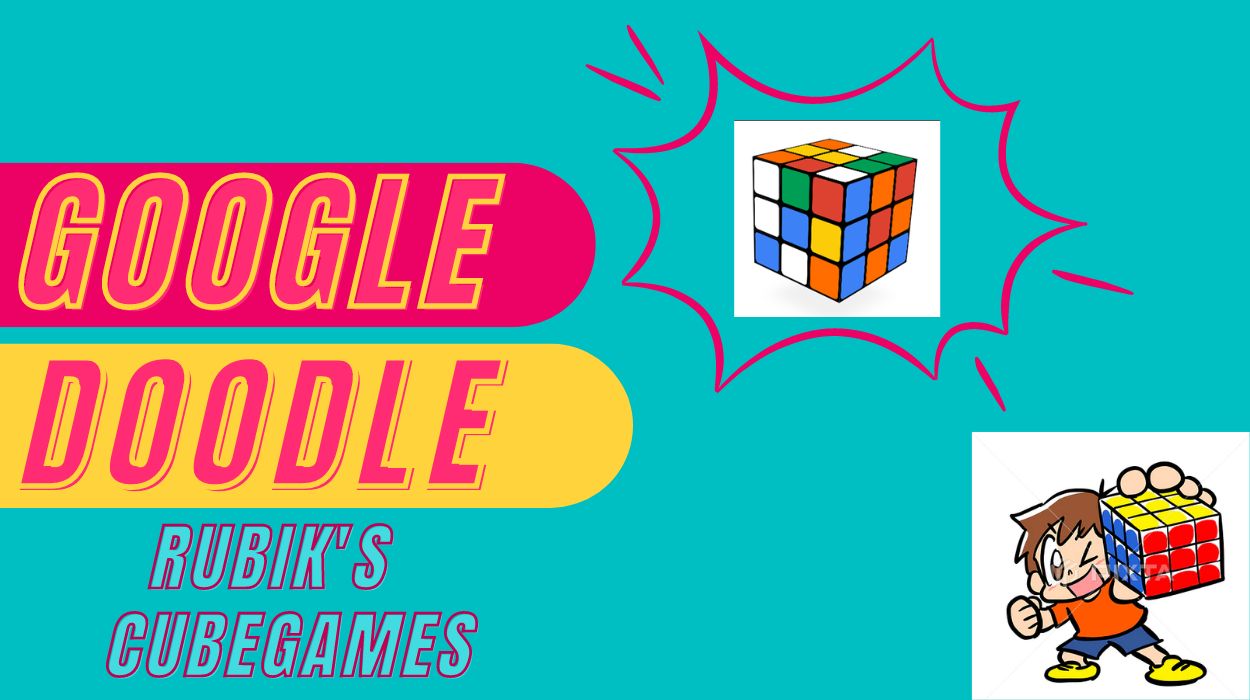Hook : The Google Doodle Rubik’s Cube game is a fun and engaging twist on the classic mystery that has captivated minds for decades. This interactive interpretation brings countless challenges to your screen, offering a fun and accessible way to test your problems.
Thesis Statement : In this blog post, you’ll discover the secrets to conquering theGoogle Doodle Rubik’s Cube Challenge. We’ll guide you through essential tips, smart tricks, and effective strategies to help you master the mystery and enhance your work skills. Whether you’re a beginner or looking to improve your speed, this companion has something for everyone.
History and Evolution of Google Doodle Games
Origins of Google Doodles: Google Doodles began as a creative way to celebrate addresses and important events. Indeed, the first doodle appeared in 1998, showing a stick figure behind Google’s totem so writers were at the Burning Man Jubilee. This simple idea grew into a tradition of using sports and cultural changes to mark important dates.
Introduction to Games : As technology advanced, Google Doodles became more interactive. In 2010, Google launched its first interactive doodle, the equivalent of Pac-Man, which was a huge megahit. This success paved the way for more interactive games, which added a fun, engaging element to the Doodle experience.
Rubik’s Cell Doodle In 2014, the Rubik’s Cube Doodle was created to celebrate the 40th anniversary of the famous puzzle. It let people try solving a virtual Rubik’s Cube right from their Google homepage. The Doodle was made to be fun and bring back memories, capturing the spirit of the classic puzzle and making it easy for a new generation of players to enjoy.
Getting Started with the Rubik’s Cube Challenge
Accessing Yum: To find and start the Google Doodle Rubik’s Cube game, follow these steps:
Open web browser and go to the Google home page.
In the search bar, type “Google Doodle Rubik’s Cube” and press Enter.
Click on the doodle link that appears, and you’ll be taken to an interactive Rubik’s Cube game.
Game Interface Overview:
Once you open the game, you will see a 3D Rubik’s Cube on the screen.
You can rotate the cube by clicking and dragging with your mouse.
On mobile devices, use your finger to swipe and turn the cube.
The game interface includes buttons to reset the puzzle, rotate it, and undo the move.

Basic Moves: To solve the Rubik’s Cube, you need to learn a few basic moves:
Rotation: Each face of the cube can be rotated clockwise or counterclockwise.
Notations: Learn standard notations such as U (up), D (down), L (left), R (right), F (front) and B (back) to understand the sequence of motion.
Algorithms: Familiarize yourself with simple algorithms, which are sequences of moves designed to achieve specific results, such as correctly positioning a corner piece.
With these basics, you’re ready to dive in and solve the Rubik’s Cube challenge!
Understanding the Rubik’s Cube Mechanics
Anatomy of a Rubik’s Cube:
A Rubik’s Cube is made up of 26 smaller cubes, which form the six sides of the big cube. Each side has 9 squares, making a 3×3 grid. There are three types of pieces: center pieces (in the middle of each side), edge pieces (with two colored stickers), and corner pieces (with three colored stickers). The center pieces show what color each side will be.
Color Patterns:
The Rubik’s Cube has six colors, one on each face. Understanding the standard color scheme (usually white versus yellow, blue versus green, and red versus orange) helps solve the puzzle. Recognizing color patterns is crucial because it allows you to predict and plan moves to position each piece correctly.
General Algorithms:
Algorithms are predetermined sequences of actions that achieve specific results, such as the positioning or orientation of a piece. Some important algorithms include:
Cross: Aligns edge pieces to form a cross on a face.
F2L (First Two Layers): Position of edge and corner pieces in the first two layers.
OLL (orientation of last layer): Orients all pieces of the last layer so that they have the correct colors.
PLL (Permutation of last layer): Moves last layer pieces to their correct position
Strategies for Solving the Rubik’s Cube
Layer-by-layer method:
This is the most common method of solving Rubik’s Cube, which is divided into three main steps:
First Layer Cross: Begin by solving a cross on the first layer, aligning the edge pieces with the center pieces.
First Layer Corners: Position the corner pieces to complete the first layer.
Edges of the second layer: Fix the edges of the middle layer, placing them correctly between the corner pieces.
Last Layer Cross: Create a cross on the last layer using the algorithm.
Last Layer Corners: Position and orient the corner pieces of the last layer.
Final Alignment: Use the algorithm to place the edges of the final layer in their correct position, completing the cube.

Speed Cubing Technique:
For those who want to solve the cube quickly, the speed cubing technique is useful:
Finger Tricks: Learn to turn the cube quickly and efficiently using your fingers instead of your whole hand.
Look: Practice predicting your next moves while completing the current one to minimize lag.
Advanced Methods: Discover methods like CFOP (Cross, F2L, OLL, PLL), Roux, or ZZ, which are optimized for speed.
Algorithm Memory: Memorize more algorithms to handle different scenarios faster.
Common pitfalls and how to avoid them:
Avoiding pitfalls can make your troubleshooting experience smoother:
Improper cross: Make sure the cross is correctly aligned with the center pieces to avoid problems later.
Misalignment: Watch your moves to avoid misaligning the layers, which can further scratch the cube.
Overreliance on Algorithms: Understand the purpose of each algorithm rather than just memorizing it, which helps in problem solving.
Practice regularly: Regular practice helps strengthen your solving technique and reduces errors over time.
Practice Makes Perfect
Daily Practice Routines:
To improve your speed and accuracy, incorporate these practice routines into your daily schedule:
Warm-up solutions: Start with a few warm-up solutions to get into a rhythm.
Focus on specific steps: Spend time practicing individual steps of the solving process, such as Cross or F2L.
Timed solutions: Time your solutions regularly to monitor your speed.
Review and Correct: Analyze your solution to identify and correct errors.
Algorithm Practices: Practice algorithms over and over to ensure they become second nature.
Online Resources and Communities:
Engage with these resources to learn new techniques and connect with other enthusiasts:
Cubing websites: Sites like CubeSkills and Speedsolving.com offer tutorials and tips.
YouTube Channels: Watch videos from popular cubers like Jay Param and Cubing World.
Forums: Join forums like the Speed Solving Forum to discuss strategies and share experiences.
Social Media Groups: Participate in Facebook groups and Reddit communities dedicated to solving the Rubik’s Cube.
Mobile apps: Use apps like Cube Solver and Rubik’s Cube Timer to practice and improve.
Tracking progress:
Use these tools and methods to track and increase your solve times:
Timer: Use online timers or mobile apps to record your solving times.
Spreadsheets: Keep a spreadsheet to log your times and track improvement over the weeks and months.
Solve analysis: Evaluate your solution using tools like Cubing Time or CsTimer to identify areas for improvement.
Goal Setting: Set specific, achievable goals to motivate and measure progress.
Regular reviews: Periodically review your progress to see how far you’ve come and adjust your practice routine accordingly.
Benefits of Playing the Rubik’s Cube Doodle Game
Cognitive Benefits:
Solving a Rubik’s Cube enhances several cognitive skills:
Problem Solving: Tackling cube challenges improves logical thinking and problem solving skills.
Memory: Memorizing algorithms and recognizing patterns enhances memory and recall.
Spatial Awareness: Manipulating the cube increases spatial perception and hand-eye coordination.
Stress relief:
Engaging with a Rubik’s Cube can have therapeutic effects:
Mindfulness: Focusing on a puzzle can be a form of meditation, helping to clear your mind and reduce stress.
Distraction: Solving the cube provides a healthy distraction from daily worries and stresses.
Accomplishment: Completing a puzzle gives a sense of accomplishment, boosts mood and confidence.
Fun and Education:
Rubik’s Cube offers the perfect combination of fun and learning:
Interactive fun: The game is fun and engaging, offering a satisfying challenge.
Educational tool: It teaches important concepts like algorithms and geometry, making learning fun.
Skill development: By playing, you develop persistence, patience, and critical thinking skills.
FAQs About the Rubik’s Cube
How do you play the Rubik’s Cube on Google Doodle? To play the Rubik’s Cube on Google Doodle, open your web browser and go to the Google homepage. Type “Google Doodle Rubik’s Cube” in the search bar and press enter. Click on the Doodle link that appears, and you’ll be taken to the interactive Rubik’s Cube game where you can use your mouse or finger to rotate and solve the cube.
Is Rubik’s Cube a brain game? Yes, the Rubik’s Cube is considered a brain game. It challenges your cognitive abilities, enhances problem-solving skills, and improves memory and spatial awareness.
Do Rubik’s cubes use math? Yes, Rubik’s Cubes involve mathematical concepts. Solving the cube often requires understanding algorithms and permutations, which are mathematical operations. The puzzle also involves combinatorial mathematics to understand the possible positions of the pieces.
Is Rubik’s cube IQ related? Solving a Rubik’s Cube is not directly related to IQ, but it does require logical thinking, pattern recognition, and problem-solving skills. While a higher IQ might help with these abilities, anyone can learn to solve the Rubik’s Cube with practice and persistence.
How To Solve A Rubik’s Cube? To solve a Rubik’s Cube, you typically follow these steps:
- Solve the First Layer Cross: Align edge pieces to form a cross on the first layer.
- Solve the First Layer Corners: Position corner pieces to complete the first layer.
- Solve the Middle Layer Edges: Place the edge pieces of the middle layer.
- Solve the Last Layer Cross: Form a cross on the last layer using specific algorithms.
- Solve the Last Layer Corners: Position and orient the last layer’s corner pieces.
- Permute the Last Layer Edges: Move the last layer edges to their correct positions.
Is solving Rubik’s cube a skill? Yes, solving a Rubik’s Cube is a skill that can be developed with practice. It involves understanding and applying algorithms, recognizing patterns, and improving hand-eye coordination.
What are the 2 moves to solve a Rubik’s cube? There isn’t a two-move solution to completely solve a Rubik’s Cube, but the simplest algorithms often used in beginner methods are:
- R U R’ U’ (commonly used to position pieces)
- F R U R’ U’ F’ (commonly used to orient pieces)
These algorithms are part of more complex sequences needed to solve the cube.
Is cubing good for your brain? Yes, cubing is good for your brain. It improves memory, enhances problem-solving skills, boosts spatial awareness, and promotes the development of fine motor skills. Engaging with the Rubik’s Cube also encourages perseverance and patience.
Conclusion
In this blog post, we explore the interesting world of the Google Doodle Rubik’s Cube Challenge. We begin with a short history of Google Doodles and how they became interactive games. Next, we give a detailed guide on how to start with the Rubik’s Cube, learn how it works, and master it with smart strategies. We also talk about the importance of practicing every day, using online resources, and keeping track of your progress. Finally, we discuss the mental, therapeutic, and educational benefits of playing the Rubik’s Cube Doodle game.
Google Doodle Rubik’s Cube Google Doodle Rubik’s Cube Google Doodle Rubik’s Cube Google Doodle Rubik’s CubeGoogle Doodle Rubik’s CubeGoogle Doodle Rubik’s CubeGoogle Doodle Rubik’s Cube Google Doodle Rubik’s Cube Google Doodle Rubik’s Cube Google Doodle Rubik’s CubeGoogle Doodle Rubik’s Cube Google Doodle Rubik’s Cube Google Doodle Rubik’s Cube Google Doodle Rubik’s Cube <div/hidden>
